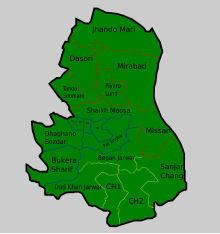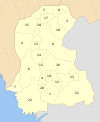Tando Allahyar District
This article needs additional citations for verification. (November 2019) |
Tando Allahyar District
| |
|---|---|
 Field in Tando Allahyar district | |
 Map of Sindh with Tando Allahyar District highlighted | |
| Country | |
| Province | |
| Division | Hyderabad |
| Headquarters | Tando Allahyar |
| Government | |
| • Type | District Administration |
| • Deputy Commissioner | N/A |
| • District Police Officer | N/A |
| • District Health Officer | N/A |
| Area | |
• Total | 1,554 km2 (600 sq mi) |
| Population (2017)[1] | |
• Total | 838,527 |
| • Density | 540/km2 (1,400/sq mi) |
| Time zone | UTC+5 (PST) |
| Number of Tehsils | 3 |
| Website | Tando Allahyar Official webpage |
Tando Allahyar District (Template:Lang-sd, Template:Lang-ur) is a district in the province of Sindh in Pakistan. Prior to becoming a separate district, it was part of Hyderabad District.
History
The city of Tando Allahyar, was established with the construction of a fort by Mir Allahyar Khan Talpur in 1709. A large number of people seeking security and refuge moved to this area under the protection of the Mir, booming the trade in the region. As the city developed over the next decade, the area started to be known as Allahyar Jo Tando (Allahyar's Town).
The shrine of legendary Sindhi folk wisdom character and Sufi poet Watayu Faqeer is also situated in Kuba Shareef near Rashidabad.
In 1906 during the British Raj, a railway station was constructed in Allahyar Jo Tando. The station increased the district's importance as an agro-trading hub. Allahyar Jo Tando was then renamed to Tando Allahyar.
The British Raj brought the fort of Mir Allahyar under its official use. This fort is now known as the Kacho Qilo; however, some decorated walls from the times of Mir Allahyar Khan are still present. After the construction of the canal in 1933, the city of Tando Allahyar turned into agricultural heaven. Before 1947, the city had a large number of Hindu followers. The Ramapir Temple of Baba Ramdevji Rama-Pir was a symbol of Hindu-Muslim unity and peaceful co-existence. However, after the Indian Partition, a number of Hindu followers took refuge in India. The temple still stands tall in the town center, attracting hundreds of pilgrims from all around the region. Tando Allahyar district was formed by dividing the Hyderabad district along with Matiari and Tando Muhammad Khan districts in 2005.[2]
As of 2021, Tando Allahyar is a bustling overpopulated urban town; although it is ill-planned and lacks proper governance, the historic town still has much to offer to its residents and its ever-increasing new settlers. The city is the center a of Sunni Hanafi (preacher) and attracts many visitors each Friday night. It also had old village named, Khan Muhammad Bozdar, about 200 years old. This village has only 52 houses with only the Bozdar caste residing in it. There is also an Astana e Aalia near Jamia Samdia Masjid Tando Allahyar where the Khalifa namely Pir Akhtar Shaheeni Saifi of Pir Abu Saalim Saifi Naqshbandi teaches the lesson of Sufism.
Dr. Rashid Shar Baloch held the Social Awareness & Assistance Forum (SAAF) in the district, giving a new ideology for the village state and village banking to financially empower people and capacity enhancement. The philosophy of SAAF Sindh based on the rural development and urban enlightenment movement towards the cognitive development of behavior and approach.
Administration


The district is subdivided into the three tehsils which contain a total of 20 Union Councils:[3]
Education
District Tando Allahyar is ranked at the 92nd position in the education score index of the Pakistan District Education Rankings 2017 published by Alif Ailaan. The education score is composed of the learning score, retention score, and gender parity score. In the middle school infrastructure index, which focuses on the availability of basic facilities and the building condition, Tando Allahyar ranks 75th. However, there was a steep improvement in almost all infrastructure indicators in Tando Allahyar in the year 2016-2017 including more availability of electricity and drinking water, access to toilets, and better building conditions.[4]
Using data from the Standardized Achievement Test (SAT) report published by the Sindh government in 2017, it was found in the "2013-2018 Five Years of Education Reforms in Sindh. Wins, Losses and challenges for 2018-2023." report that Tando Allahyar ranked 8th for student achievement in the language in grade 8. However, with a score of only 41.68, it is still below average. In grade 8, Tando Allahyar ranked at the 7th position for student achievement in maths and 6th position for science.[5]
Administrative and infrastructure issues remain a hindrance for every child in district Tando Allahyar to access free and quality education. Issues reported by the residents via the Taleem Do! App complain of the lack of absenteeism of teachers, lack of basic facilities, and the prevalence of shelter-less schools and closed schools. Some citizens also appeal for their children to be educated in the regional language, Sindhi, rather than Urdu or English. The debate on whether basic education should be provided in the regional, national or official languages has been a point of debate in Pakistan for several years.[6][7][8]
Agriculture
Mangoes are abundantly cultivated in Tando Allahyar. It is one of the richest areas of the country in terms of agriculture. Cash crops such as sugarcane, wheat, onions and cotton are cultivated in majority. Besides, orchards are spread over hundreds of acres of land.
The farmers of Tando Allahyar play a vital role in the production of vegetables, which are supplied to Karachi. The city has one of the highest yields in the province as it produces the highest quantity of sugarcane, with around 50 to 60 million maunds of sugarcane worth of annual production.
Seed companies in Tando Allahyar
- Advance Seed Corporation
- Super Haari Seed Corporation (Regd)
- Patan Seed Corporation (Regd).
- TASCO SEED Corporation (Regd)
- Hyefa Seed Corporation (Pvt.) Ltd.
Demography
At the time of the 2017 census, Tando Allahyar district had a population of 838,527, of which 432,697 were males and 405,709 females. The rural population was 570,428 (68.02%) and urban 268,099 (31.97%). The literacy rate is 38.23%: 47.96% for males and 27.90% for females.[1]
Religion
The majority religion is Islam, with 65.54% of the population. Hinduism (including those from Scheduled Castes) is practiced by 34.17% of the population. Hindus are nearly 40% in rural areas.[1]
The district hosts one of the major Hindu pilgrimage centre in Pakistan, the Shri Ramdev Pir temple,[9] whose annual festival is the second-largest Hindu pilgrimage center in Pakistan.[10]
Language
At the time of the 2017 census, 80.90% of the population spoke Sindhi, 8.50% Urdu, 3.53% Punjabi, 1.51% Balochi and 1.33% Saraiki as their first language.[1]
Culture

Tando Allahyar has rich Sindhi culture. Men clad themselves with the national style of dress called Shalwar Kameez having broader bottoms and traditional caps. Women clad with 'Gharara' or 'Parro' with bangles all the way up till shoulders.
Clogging Road side tea stalls with colleagues and friends is a favorite pastime for men.
List of Dehs
The following is a list of Tando Allahyar District's dehs, organised by taluka:[11]
- Jhando Mari Taluka (38 dehs)
- Aelchi
- Bulghia
- Chhachharki
- Daro Sutah
- Daseeri
- Dhaghki
- Gahaiki
- Ghado
- Hadeki
- Halepotani
- Mashaikh Hothi
- Hingorani
- Hotki
- Kathari
- Kehi
- Khado
- Koraiki
- Koryani
- Langhano
- Makhoro
- Missan
- Narahado
- Nelorai
- Nimro
- Noori
- Palhi
- Rajpari
- Rappar
- Roopah
- Sajnah
- Seharki
- Seharpur
- Sonhari
- Thebaki
- Vesarki
- Wagori
- Waryaso
- Tando Allahyar Taluka (24 dehs)
- Chambar Taluka (29 dehs)
References
- ^ a b c d e "District-wise Tables - Census 2017 Final Results". pbs.gov.pk. Pakistan Bureau of Statistics. 2017.
- ^ "Three new districts carved out of Hyderabad". TheDawn. 5 April 2005. Retrieved 31 July 2021.
- ^ District Government of Tando Allahyar Archived 2013-05-21 at the Wayback Machine
- ^ Alif Ailaan 2017. Pakistan District Education Rankings 2017. Islamabad: Alif Ailaan. vi-66 pp. ISBN 978-969-7624-06-5
- ^ Alif Ailaan 2018. 2013-2018 Five Years of Education Reforms. Wins, Losses, and challenges for 2018-2023. Islamabad: Alif Ailaan. vi-42 pp. ISBN 978-969-7624-08-9 The LFTS (Leading Future Testing Service), has also launched for testing purposes. the service launched for the purpose to promote test patterns and enrich the student's faculties. Its first project started as GAT General Assessment Test. The test Date will be 14th Oct 2018. Website. www.lfts.jigsy.com https://elections.alifailaan.pk/wp-includes/file/SindhEducationReport18.pdf
- ^ "When language is a bar to learning | #TaleemDo". elections.alifailaan.pk.
- ^ Mustafa, Zubeida (2012-12-25). "Language in Sindh schools". DAWN.COM.
- ^ "Why should Sindhi be taught in all schools of Sindh?". Retrieved 2018-08-03.
- ^ "PESA Tandoallahyar" (PDF).
- ^ "Hindu's converge at Ramapir Mela near Karachi seeking divine help for their security - The Times of India". The Times of India. Retrieved 2020-09-09.
- ^ "List of Dehs in Sindh" (PDF). Sindh Zameen. Retrieved 22 March 2021.
Bibliography
- 1998 District census report of Hyderabad. Census publication. Vol. 59. Islamabad: Population Census Organization, Statistics Division, Government of Pakistan. 1999.

